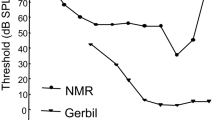Abstract
Thresholds for pure tone detection were examined in the common mole-rat, Cryptomys sp. (Bathyergidae, Rodentia) using a positive reinforcement procedure. To bypass the problems connected with testing isolated individuals of this extremely social species, a collective behavioural audiogram was determined for a family group of seven mole-rats. Within the tested frequency range of 225 to 18 kHz, the lowest thresholds (as low as 7.5 dB SPL, on average 24 dB SPL) were found at 800 Hz, the upper limit of hearing (at the level of 60 dB SPL) was at 18 kHz. The behavioural audiogram combines the results of previous studies on hearing in this species. It resembles the distortion threshold curve but differs from neurophysiological data as far as the high frequency cutoff is concerned. On the other hand, the region of the best hearing sensitivity is narrow in behavioural audiogram and neurophysiological curves but rather broad in the distortion threshold curve. In general, the behavioural audiogram of Cryptomys is in many aspects comparable with the available audiograms of other subterranean rodents.
Similar content being viewed by others
Author information
Authors and Affiliations
Additional information
Accepted: 18 February 1997
Rights and permissions
About this article
Cite this article
Brückmann, G., Burda, H. Hearing in blind subterranean Zambian mole-rats (Cryptomys sp.): collective behavioural audiogram in a highly social rodent. J Comp Physiol A 181, 83–88 (1997). https://doi.org/10.1007/s003590050095
Issue Date:
DOI: https://doi.org/10.1007/s003590050095



